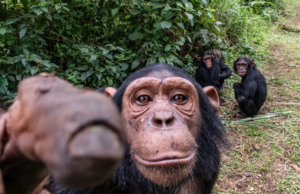The enigma of chimpanzees

Rodrigo is a deaf-mute boy from Rio, student of the eighth grade. One day he was visiting the zoo of Rio de Janeiro, reluctantly, since he hates seeing animals as prisoners in cages; but it was a task of Sciences.
With this amazing dialogue, this simple 61-page book begins, with the title “The enigma of chimpanzees”. The plot is a well-crafted fiction story that shows the suffering of our fellow primates in the hands of pseudo scientists in laboratories of medical experimentation.
“THE MYSTERIOUS CHIMPANZEE
— Scientist boy, come here!
The one who was calling me was Paulinho “Funk”, a pint-sized prankster who called himself “king of suburban dances.”
He and the rest of the group were crushed in front of the fence of the tamarins. Although it was forbidden, they threw pieces of snack for the animals and got fun with the noise of the monkeys and the fights for the possession of the food.
— See — Paulinho “Funk” said, pointing to the last cage of the monkeys’ area.
A sad and deep-eyed adult chimpanzee was sat alone on the cement floor, oblivious to everything.
— He knows how to make signs just like you, laughed Maria Lucia, the most annoying girl in the room.
— It’s true — Paulinho amended, beginning to shake hands in front of the cage and mimicking my gestures awkwardly.
To my surprise, the chimpanzee looked up to my colleague, watching him intently, as if trying to decipher the strange message. He approached to the grid, shook his head, showing signs that he did not understand anything.
Then something fantastic happened.
The animal, oddly enough, tried to communicate with Paulinho, using the language of the deaf and dumb! The hairy fingers opened and closed, transmitting the alphabet clearly.
— I do not understand. Who are you? — asked the chimpanzee, almost making me fall backwards.
— Did you see? — Paulinho said. What was he saying? — asked with an mockery air.
— He is not saying anything — I responded with extreme difficulty. — Chimps just like to imitate people, that’s all — I misled, barely containing nervousness and excitement.
— I told you! — Maria Lucia cried. — Wouldn’t this be odd, monkeys who can speak! — It would, agreed Paulinho. — Let’s go. The class has already gone — said, pulling the blonde’s arm.
I was there, static, unable to believe what I had just witnessed. The chimpanzee sat back, with shoulders hunched, like a tired old man.
There was nobody else around now. Taking courage, I reached out and knocked lightly on the grill. The animal turned away his almost human face to me. His intelligent eyes were staring at me.
— My name is Rodrigo. Who are you?— I asked, using only my hands.
The look of the chimp suddenly lit up with joy. In a jump, he got to his feet and responded with clear and precise gestures:
— Take me out of here.
I was not dreaming. The chimpanzee knew the language of the deaf and dumb! He should have learned from someone;
— Who taught you to use the signs?— I asked again.
— Long hair woman — he said — putting his hands on his hips to show how far was length of her hair.
— What is her name?
— Jo-an-na, he spelled.
— Where?
— Place lot of cages.
— Where are you from? — I asked anxiously.
— House with bad people. Near Giant Stone — he said — imitating the image of Christ Redeemer, in Rio de Janeiro.
At that moment, our conversation was interrupted by the arrival of the teacher:
— Rodrigo, Rodrigo. It’s time to go. You are the just one missing. Come on — she called — retreating hastily as ever.
— Goodbye. I come back tomorrow, I said to the chimpanzee.
— Come, he asked me with a sad and stressed look.
— Yes.
On the way back, I sat in the last seat. My heart was pounding . And now? I could not tell it to anyone. They would fall on my skin and call me crazy. For now, everything had to be kept in secret. (…) “
The story develops to an adventure in which the deaf-mute Rodrigo, a newly-formed biologist, Fernando, and an Indian (half Brazilian and half Bolivian) called Joana end in a center of medical experiments near Santa Cruz de la Sierra, Bolivia , where dozens of baby chimpanzees are tested with various diseases and others are trained to be used in cocaine trafficking.
This sinister plan is unmasked by the group, which ran away Brazil, in the Train of Death, from Santa Cruz, Bolivia, to Puerto Suarez, on the border with Mato Grosso.
The author of the narrative, Rogério Barbosa Andrade, has more than a dozen books published, most directed at a young audience. Roger confesses that the inspiration to his reports are the experiences from his travels around the world. For this book, it was the travel in the Bolivian Death train and the work of primatologist Jane Goodall with chimpanzees in Africa.
This book was published in 1993 but remains current until today, showing that zoos have evolved for the worse and that practices of corruption and torture, mixed with indecent politics, still permeate every corner of our society.

 Español
Español
 Português
Português








